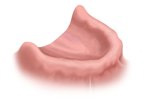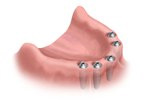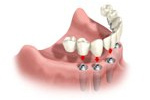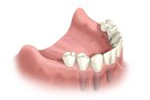Full Arch Replacement
Full Arch Dental Implants in Bend, OR
When all teeth are missing or in such condition that they need to be replaced, a fixed bridge anchored to dental implants is the best permanent solution.
Before dental implants, there was no fixed solution available for people who lost all their teeth. Today, it is possible to replace a full jaw with dental implants and a fixed bridge that results in a permanent, stable and high esthetic solution.
- Lets you eat and function like having natural teeth
- A solid, stable solution that will serve you for life
- Preserves your facial appearance and prevents bone loss
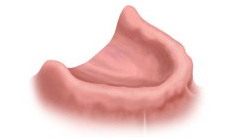
Installing a Fixed Bridge Step by Step
The treatment procedure and number of visits is largely dependent on the specific conditions. But all in all, 8-10 visits should be enough to have a fixed bridge installed. Most patients report that they were much more comfortable following the procedure than they had anticipated.
- Before the procedure: The dentist determines what needs to be done and prepares both himself and the patient for the coming treatment procedure.
- Installing the implants: The first step is installing dental implants to replace the lost tooth roots. In this case, five implants are used. Temporary teeth are attached that enable you to eat and function like normal while waiting for the permanent bridge to be installed.
- Attaching the bridge: The final bridge is securely installed on top of the implants. With a full jaw replacement like this, it normally takes 2-3 visits to have the bridge completely attached.
- End result: Your new teeth should be hard to tell from natural – both for you and others. People who have had traditional dentures before getting a fixed bridge often describe this as an overwhelming and very positive experience.
Alternatives to an All-Ceramic Crown On Implant
While all-ceramic crowns offer excellent aesthetics for single tooth replacement, alternatives may be considered in cases of high bite force, teeth grinding, limited space, or budget constraints.
 A traditional bridge involves grinding down adjacent teeth to support the bridge. It is a stable solution with good esthetics and function that is fairly easy to install. However, this alternative has two main disadvantages: continuous bone resorbtion in the edentulous area, and sacrificing healthy teeth on behalf of the bridge.
A traditional bridge involves grinding down adjacent teeth to support the bridge. It is a stable solution with good esthetics and function that is fairly easy to install. However, this alternative has two main disadvantages: continuous bone resorbtion in the edentulous area, and sacrificing healthy teeth on behalf of the bridge.
 This is not a permanent alternative to a lost tooth. It is unstable and loosely attached, which affects both function and comfort. A removable partial denture is made of plastic – a material that can’t create the same esthetic result as a ceramic crown. The benefits are few but do exist: adjacent teeth aren’t affected. It is easily and quickly installed and relatively cheap.
This is not a permanent alternative to a lost tooth. It is unstable and loosely attached, which affects both function and comfort. A removable partial denture is made of plastic – a material that can’t create the same esthetic result as a ceramic crown. The benefits are few but do exist: adjacent teeth aren’t affected. It is easily and quickly installed and relatively cheap.
 This alternative has some clear advantages: it is quickly installed, functions well and, since it is made of ceramic, it gives a high esthetic result. Moreover, natural healthy teeth aren’t affected. But it is not very permanent. The resin-bonded bridge will eventually come off – probably after just a couple of years – and will then have to be reinstalled.
This alternative has some clear advantages: it is quickly installed, functions well and, since it is made of ceramic, it gives a high esthetic result. Moreover, natural healthy teeth aren’t affected. But it is not very permanent. The resin-bonded bridge will eventually come off – probably after just a couple of years – and will then have to be reinstalled.

Get In Touch With Us!
This procedure normally includes four visits to the dentist. You should expect to be able to work the day after having the implant installed.

